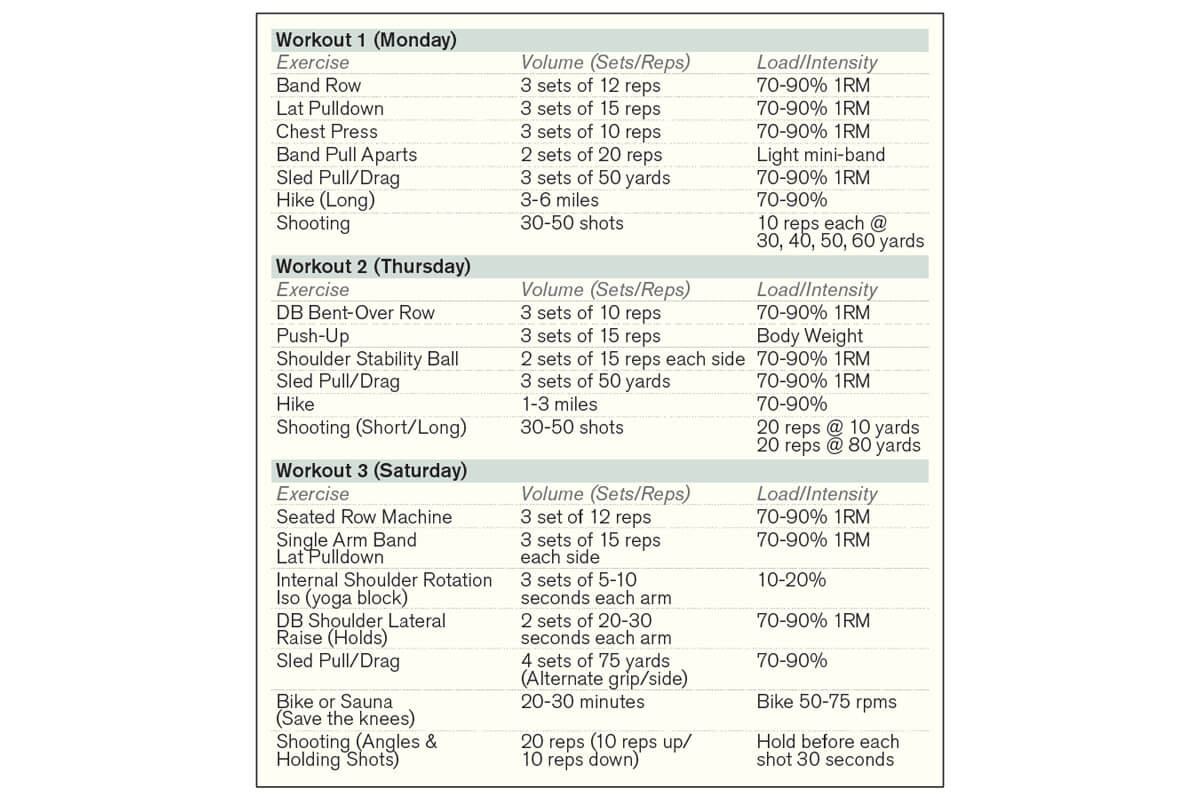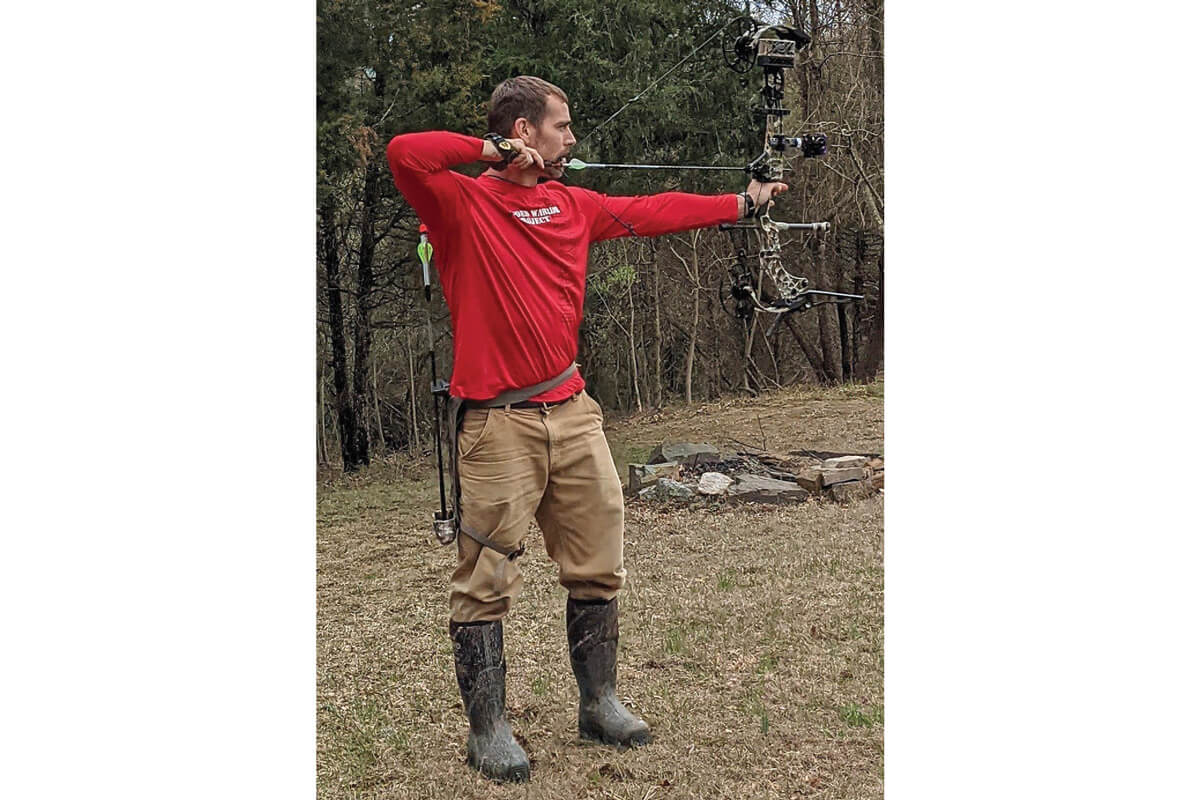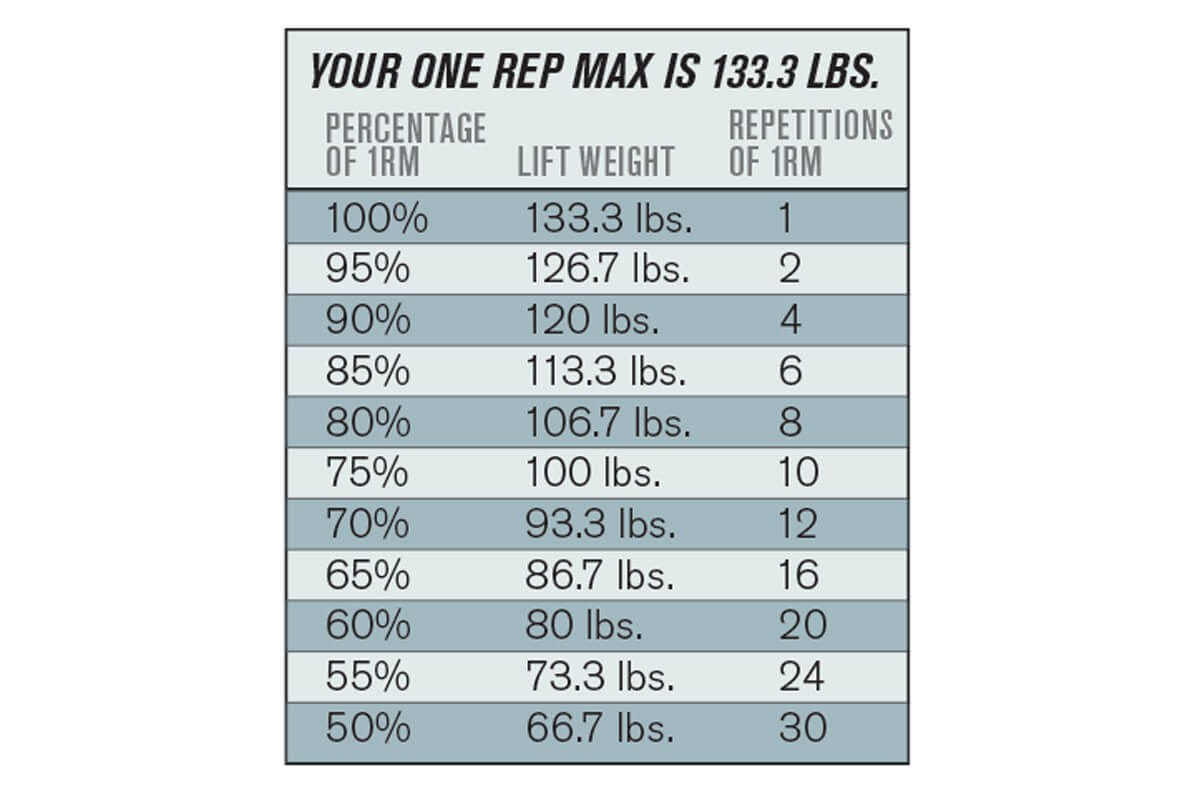
(Author photos)
As the CEO of Science of Cardio, I have been training clients for over 15 years. Working with many talents and abilities, my expertise ranges from professional athletes to retirees, young adults, and rehab clients. I am also an avid bowhunter. Like the mountains called to John Muir, I say “The woods are calling me and I must go.”
Hunting is my soul and my passion. I am always asking myself, “How can I get in shape for the steep terrain? Can I hit my target at 70, 80, or 90 yards? Do I have the stamina to go from sunrise to sunset? Can I do anything to prepare for, or prevent injuries? Do I have the grit and toughness to arrow my once-in-a-lifetime animal?
Basic Strength-Training Tips
Be cautious and start slowly when training for a vigorous hunting trip. Too many people try to build “Rome in a day.” Make it a slow and steady micro-progression. Your first workout should be on the light side of weight or resistance. Exercise is about stress and the recovery process. You stress your tissues (nerves, muscles, bones, tendons, ligaments) when you lift weights or engage in other exercise. When you rest, the repair process begins and the magic happens. During the resting or recovery process is when your muscles grow as they repair damaged tissues/cells. When you stress and rest your body every other day and repeat the process over eight to 10 weeks, you will adapt to the stress and get stronger, more efficient, and in better shape.
Going too hard or fast out of the gate will most likely result in an injury, typically joint bursitis or tendonitis — both inflammation injuries. Sometimes, stress fractures occur when too much stress is put on the bones too fast, and they don’t have time to repair themselves. When in doubt: Be the tortoise, not the hare.
My advice is to exercise every other day to prevent overuse injuries and allow your body to heal/repair before challenging it again. You can even take this healing/repairing advice one step further by taking an entire week off every two to four months. This is a trade secret of strength and conditioning coaches, college and professional sports teams, and Olympians. It’s called “supercompensation.” There is science behind what professionals do: If it’s good for them, it will work for you.
Exercises For Becoming A Better Bowhunter
The following are some helpful exercises, tips, and tricks for bowhunting fitness that I personally implement for optimal success. (Note: These are suggestions/recommendations that can be modified depending on your personal fitness level, ability, and equipment. Please consult your physician before starting any exercise program.)
Back Rows — Back and shoulder muscles used to draw your bow.
Three sets of 10-12 reps (2-3x per week @ 70-90% effort). This can be done with a dumbbell, barbell, or an elastic band. Standing or seated. An alternative is a bent-over row.
Lat Pulldowns — Pulling muscles in the upper back for climbing up in a treestand.
Three sets of 15-20 reps (2-3x per week @ 70-90% effort). This can be done with a cable machine or an elastic band. Typically seated. Alternatives are pull-ups or chin-ups.
Chest Press — Shoulder muscles for pushing/stabilizing/holding your bow.
Three sets of 8-12 reps (2-3x per week @ 70-90% effort). This can be done with a dumbbell, barbell, or an elastic band. Standing or seated. An alternative is a push-up.
Hike — Build up leg strength and endurance.
Beginners (1-3 miles), Intermediate (3-6 miles), Advanced (6+ miles).
Hiking uphill requires more energy and a higher cardio challenge, but going downhill is more of a muscle challenge to stop the body from falling. I recommend both. Include loads/packs for meat-hauling and camping gear (2-3x per week).
Sled Drag/Pull — Getting your game from field to vehicle/camp.
Use a snow sled, and maybe add a sandbag or buy a metal-weighted sled that you can add weights to, to simulate dragging an animal. Another option is to load a snow sled with wood or rocks and pull/drag it for a given distance.

Above all else, I recommend you shoot your bow multiple times per week. Practice shooting both uphill and downhill; take long-range shots and ultra-close shots; quick shots and those where you must hold at full draw for an extended period of time; and be sure to shoot from various positions (standing, seated, kneeling).
Intensity
Intensity for resistance training is very important to progress. If you don’t use enough weight, you won’t get results. If you go too heavy, you risk injury. I like to call it the “Goldilocks Zone” — not too small, not too big…just right. I like to use a 1-10 scale for intensity, with one being super easy and 10 being you can’t do another rep. If you are training at the 7-9 range, that will help you gain strength and promote muscle growth. I will start newbies out with two sets of 10 reps.
You will have to play around with this until you figure out your own body. Another tool that you can use for intensity is the maximum-rep calculator (look online for said calculator and you’ll understand what I mean). Try to complete a weight as many times as you can. I personally do 70-90% of my one-rep max. For example: If you bench 100 lbs. for 10 repetitions, your estimated maximum is 133 lbs. Typically, these charts will have a percent of one rep maximum (1RM) that you can use to find out your appropriate load for the proper challenge (see chart above).
With my clients, the biggest issue I deal with is them pushing through pain and using too much weight when things are injured or healing. Don’t do it. It is better to make it to the top of the mountain by the end of the day than to not make it all.
Frequency
This is a personal thing, and each individual’s gameplan should be designed based on availability, age, ability, and exercise experience. For someone who has never lifted weights or hiked much, I would start out slowly, with a break in between workouts. For example: Strength-train and go for a one-mile hike on Monday and Thursday. For someone who works out regularly, I would recommend 2-4 workouts per week. I personally strength-train twice a week; same for cardio. If you are prepping for a sheep or goat hunt in steep country, I recommend you do more aggressive hiking almost daily as you get closer to your hunt. The most important thing you can do is to listen to your body, because it will tell you all you need to know. If you start getting knee pain, you should take a break or lessen your sessions per week. Human muscles can take a break continuously for up to two weeks before they lose strength or begin to decondition. Taking a day or two off will not ruin your strength gains.
Here is an example of a Monday, Thursday, Saturday routine. Please adjust accordingly to your needs and schedule. Monday/Wednesday/Friday or Tuesday/Thursday/Saturday, etc. Be flexible, and know that something is better than nothing.
Injury Prevention
I must stress again the need to prevent overuse injuries. If you’ve dealt with bursitis, tendonitis, inflammation, arthritis, or a nagging injury, it can be challenging to get out to hunt. The solution is to address the root cause, before you get to an injury. I use prehabilitation, or “pre-hab exercises,” to prevent injuries. It’s like flossing for your joints. When you floss your teeth, it helps to protect them from decay. The same is true for your joints — use them or lose them. Bottom line: If you do not maintain your muscles, tendons, tissues, and ligaments, they will atrophy.

If you have pain in a joint, or if you notice differences between the right versus left side, then I recommend switching to hold (isometric) exercises versus traditional-movement reps, which will allow your body to use the proper muscles and nerve signals. When you put too much weight on a joint and it can’t handle the stress, your body will then compensate or figure out a way to get the job done. You may be able to finish the exercise, but that doesn’t mean it’s safe for your joints. Never work through pain. Adjust angle, position, load/weight, stop, or consult a professional.
The following are some of my favorites:
Single-Arm Stability Ball — Shoulder stability for push-and-pull arms.
Hold a stability ball on a wall at shoulder height, then do a figure-eight motion with your shoulder. You can also do circles with a ball on the wall. Do three sets of 15 reps.
Dumbbell Holds — Holding bow in a stable position (waiting for a shot).
Hold a dumbbell or weight at shoulder level in front of you and/or hold weight to the sides at shoulder height. Do three 30-second sets.
Band Row — Drawing and holding for extended periods.
Pull a band back to your shooting position and hold. Do three sets of 15-20 reps.
Band Pull-Aparts — Rotator-cuff muscles.
Hold an elastic band at shoulder level and pull both arms apart. This will engage your rotator-cuff muscles, tendons, and ligaments. Do three sets of 15-20 reps.
Internal Shoulder Rotation — Rotator-cuff muscles.
Lie on your back with your elbow at shoulder level and your elbow bent at 90 degrees. Then place a book or yoga block in front of your hand/wrist. Lower your hand/wrist down/forward to book/yoga block, and push into it. Hold with pressure for a given length of time. Three sets of 10-15 seconds.
Practice Run
Lastly, do a practice run with all your gear/equipment and food. See if you can drop some weight off your pack. Go on a hike and camping trip before the season; maybe while scouting for a game. Practice, practice, practice. I like to reverse-engineer my alpine-hunting trips by researching the area online, with books, topo maps, and guides to get elevation gains, topo, distances, etc. Then, try to work toward those goals in your preseason training. If I know I’ll be hiking six miles of backcountry with elevation gains of 2,800 feet or more, I will try to simulate that intensity at least once before I head out.

Hunting big game involves a major dedication of time, effort, and money. Being thoroughly prepared is the only way to protect that investment!
For more information about the subjects the author covered here, go to scienceofcardio.com/hunting-fitness.
The author lives, trains, and hunts with his wife, Amy, in Hancock, Maryland.







